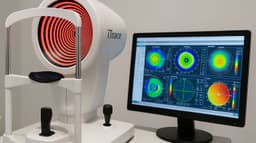
Vision Development In Babies
Long-sightedness in children is extremely commonplace and is often left untreated due to the natural correction process the body undergoes.
In this article, our expert paediatric John Bolger tells us all about vision development in babies.
What Is The Emmetropization Process?
“Did you know that almost all babies are long-sighted when they are born? In most cases, the eyes will correct themselves within 2 years through Emmetropization.
As an orthoptist, I am a specialist in helping people with squints and similar eye conditions. If I am examining a 2-year-old, glasses are not always necessary due to the commonality of both hypertropia in newborn babies and general long-sightedness in children.
On the contrary, short-sightedness in children of this age is much more unusual.
Read more about long and short-sightedness in our blog: “What are myopia, hypermetropia and astigmatism?”
Treating Long-sightedness In Children And Babies
Emmetropization is the eye’s process of aligning its axial length to the focal length of its optics. However, imperfect alignment causes short-sightedness, and both genetics and environment can have an impact on this process.
For example, there is strong evidence to suggest that children who spend less time outside are more at risk. When emmetropization doesn’t happen, light entering the eye isn’t properly focused on the retina and so the brain receives a blurred image.
A secondary effect of this is that neural pathways in the brain responsible for sight start to get ‘lazy’, thus working less effectively.
“An eye test called a refraction test needs to be done in this case as this measures which prescription lenses the child will need in order to correct their sight. If the child is given the right prescription, their vision will be immediately corrected whilst wearing the glasses, and refractive adaptation will begin.
So wearing glasses can actually exercise the visual system in such a way that the eye and brain eventually adapt to self-correct the child’s sight.
The more often a child wears glasses the more adaptation occurs. There is a bit of neuroscience behind this; because the brain now receives a clear image from the optical nerves the visual pathways in the brain are stimulated to work properly. This reawakens the neural pathways.
Refractive adaptation does not always completely restore perfect vision but does much to significantly improve it. Depending on the length of time the child’s vision has been left untouched, treatments such as occlusion may well be needed in order to further stimulate the cells, so the earlier the better.
Research shows that a full 18 weeks with glasses is the maximum potential time period for refractive adaptation to have an impact before occlusion is necessary.
Glasses make up for the miscalculation between the lens and the size of the eye; however, this will only slightly change as a child grows, as long as the prescription is very small.
In these cases, the optician may advise them to wear their glasses as teenagers when at school, work, the cinema and whilst driving. For children under the age of 10, however, it is advisable to wear glasses full-time.
Baby Vision Development Guide
| Age | Milestones |
|---|---|
| Newborn | Blurry vision, limited colour perception |
| Preference for high contrast patterns | |
| 1-3 months | Tracking objects up to 45 degrees |
| Starts to follow faces and objects | |
| 4-6 months | Improved colour vision |
| Depth perception begins to develop | |
| 7-9 months | Better hand-eye coordination |
| Refines depth perception | |
| 10-12 months | Can judge distances more accurately |
| Recognises familiar objects from a distance | |
| 12-24 months | Depth perception close to adult levels |
| Can recognise and point to familiar objects |
Noticing Poor Vision Development In Your Child
“The coordination of eye movement develops after birth once a baby sees for the first time. Whilst this vision development progresses, it can be normal for babies to look slightly cross-eyed up until about 6 months of age.
Naturally, if you’re a parent you might be concerned by this, especially if it continues beyond 6 months.
If you’re a bit worried, seek medical advice at the GP. If a problem is spotted then the GP may refer your child to a paediatric ophthalmic (children’s eye specialist), like My iClinic.
From there, a proper diagnosis and treatment plan can be made by a doctor if necessary.
If you are wondering who you need to see, here is a list of specialists and what they do in the eye world:
- Opticians and optometrists specialise in glasses and eye tests, prescribing glasses and may detect eye diseases.
- Orthoptists specialise in non-surgical diagnosis, such as the management of squints, amblyopia and eye movement disorders, isolated and secondary to systemic disease.
- Ophthalmologists are medically trained doctors and surgeons specialised in the diagnosis and treatment of eye diseases and disorders. They can also perform ‘refraction tests’ and prescribe glasses.”
20 Facts About Vision For Babies
- Newborn Vision: At birth, a baby's vision is quite blurry, and they can primarily see high-contrast patterns.
- Colour Perception: Initially, babies see the world in black and white or shades of grey. They start to develop colour vision over the first few months.
- Focus Distance: Newborns tend to focus on objects that are about 8-12 inches away from their faces.
- Rapid Development: Vision develops rapidly during the first year of life.
- Tracking Movement: By 1-3 months, babies can track objects within a 45-degree angle of their face.
- Visual Preferences: Babies often prefer looking at human faces and high-contrast patterns.
- Depth Perception: Depth perception starts to develop around 4-6 months of age.
- Eye Contact: Babies usually start making eye contact with caregivers within the first few months of life.
- Reaching and Grabbing: Around 6-9 months, babies develop hand-eye coordination, allowing them to reach for and grab objects.
- Focus and Refocus: Babies may need time to focus and refocus their eyes, especially when switching between objects at different distances.
- Visual Stimulation: Providing a variety of visually stimulating toys and objects can aid in vision development.
- Crawling and Walking: As babies start to crawl and walk, their visual experiences expand, allowing them to explore their environment more actively.
- Avoiding Overstimulation: While stimulation is important, it's also crucial to avoid overstimulation, which can lead to tired or cranky babies.
- Peripheral Vision: Babies have a wider field of vision than adults, but their peripheral vision is not as sharp.
- Object Permanence: Around 8-12 months, babies begin to understand that objects still exist even when they can't see them (object permanence).
- Recognition of Familiar Faces: By around 6 months, babies can recognise and show a preference for familiar faces.
- Visual Milestones: Every baby's vision development timeline can vary, so it's important not to compare them to others.
- Eye Health: Regular pediatric check-ups include examinations for potential vision issues, such as strabismus or amblyopia.
- Screen Time: Limiting screen time in the early years can help promote healthy visual development.
- Vision and Learning: Good vision is crucial for early learning, as it allows babies to explore and interact with their surroundings.
Exploring Vision Development With My-iClinic
We hope you’ve found this article on vision development in children and babies useful.
If you have any questions about long-sightedness in children, contact us today or book a consultation to see how we can help your child.
Find out more by Speaking to our team









